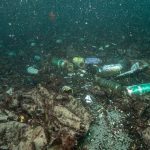TYPE
ConferenceOBSERVATION
Marine MammalsPERIOD
2000INTERVENANT
Julien MARCHAL14 pages

Hello to all,
Report for : The Greenpeace International Whaling Conference
In January 2000, Greenpeace International launched its "Whale Campaign" to run until the next IWC (International Whaling Conference) next June. Since then, local groups in every town in France have had to organize themselves to take action on this issue.
As a result, the report is a first step towards getting to know marine mammals, as we live in a region far removed from any contact with this environment. Cetaceans are hunted in some parts of the world and are subject to unprecedented marine pollution. To be able to defend ourselves and explain the essentials, we needed a minimum of knowledge.
I didn't want to do something too complicated so as to be understood by the whole group, and numerous diagrams accompany the text.
Enjoy your reading.
1. Origin and development :
Lhe origin of cetaceans can be divided into three groups: two modern and one ancient. The ancient group is found in the Upper Eocene (40 ma), where we find the first cetaceans or "archaeocetes". They gradually disappeared, giving way to the mysticetes and odontocetes, which were in the midst of an evolutionary phase. At the end of the Eocene (38 ma), the two modern groups appeared, giving the approximate form of today's cetaceans. One group would influence the evolution of cetaceans: the "creodont" family, four-legged carnivores.
An early history of cetaceans is represented by a creodont living simply near rivers, occupying the niche of eaters of corpses washed up on beaches by the sea. Then, they began to catch fish trapped in temporary coastal lagoons and ponds. Then, a sea rich in fish acted as a "passive" attractor for a "creodont" that had become semi-aquatic, a group of Condylarthra, the Mesonychids, from which we retain the "Mesonyx", a large hairy dog, ancestor of the archaeocetes.
The major oceanological change at the end of the Eocene, with its fabulous increase in ocean productivity, is the cause of the second cetacean expansion, which marks the differentiation of two modern groups. Continental drift and climate change also have an influence on cetaceans. As a result, cetaceans left the land and returned to the sea, as had many reptile species before them.
Enjoy your reading. Sincerely.
Strasbourg, 2000.
Julien Marchal




